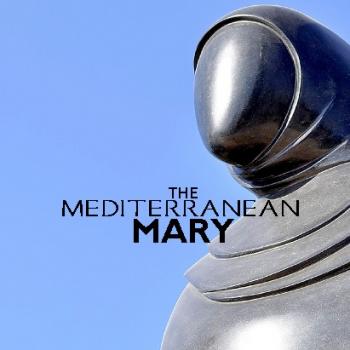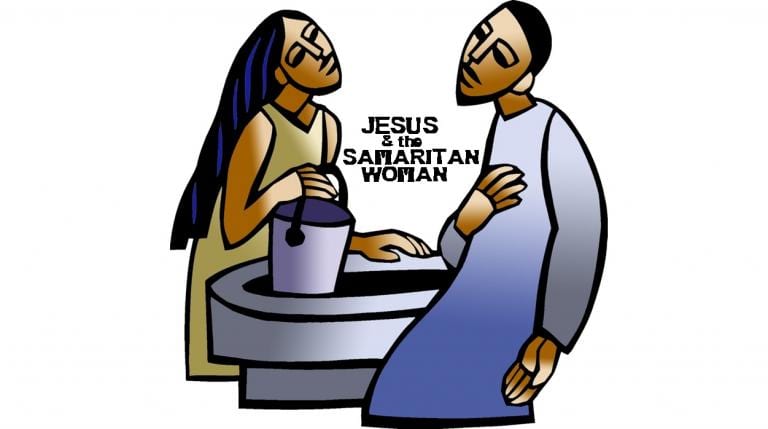
Samaritan Woman at the Well is a character from a shocking story of jarring irregularities to those familiar with the Mediterranean cultural world of the Bible.
Spurious familiarity with Gospel stories we have heard many times over often keeps us Western readers from understanding many important insights they have to offer. Such is the case with this Sunday’s selection (John 4:5-42). This is further muddled by unrealistic Western expectations stupidly and unfairly saddled onto ancient stories, such as demands that they only report what factually happened otherwise they have no value or truthfulness.
Samaritan Woman Encounter: Truthful or Factual?
Must Catholics and other Christians believe that this story of Jesus meeting a Samaritan woman actually occurred in the historical Jesus’ life? Look carefully at the Second Vatican Council’s Dogmatic Constitution on Divine Revelation, or Dei Verbum (§19), the Pontifical Biblical Commission’s, “Instruction on the Historical Truth of the Gospels” (§6-9), and the Universal Catechism (no. 126). There we see acceptance that the Gospels emerged through a three-stage process of development. Consequently, not everything within them must be factual or biographical with 21st century precision and exactitude.
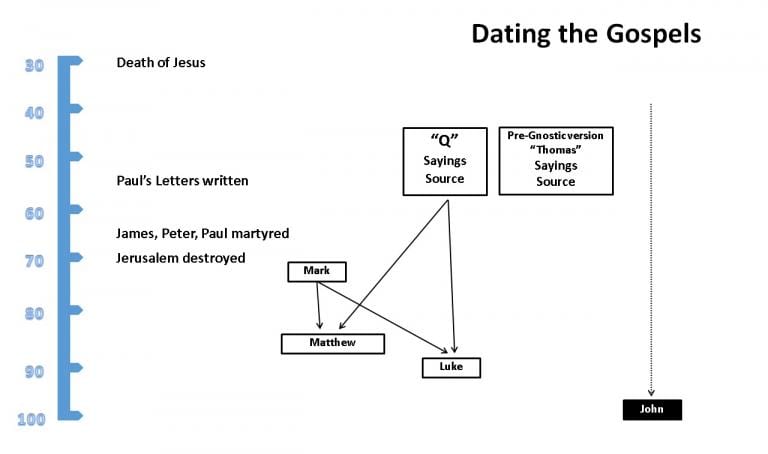
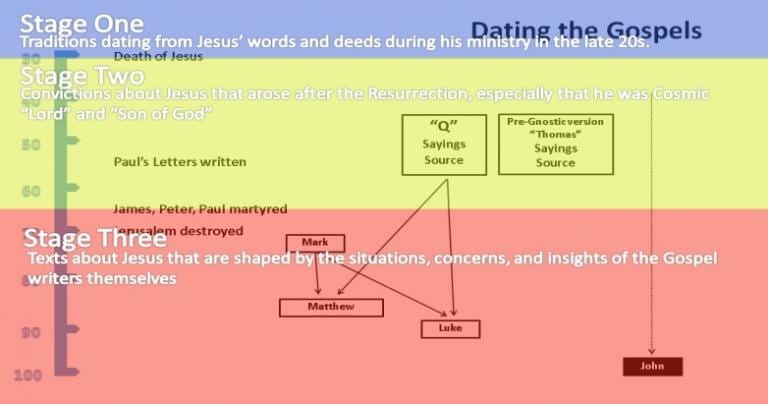
Indeed, as scholars such as John Meier and Jerome Neyrey explain, there are scholarly reasons to doubt that this encounter ever happened to the prepaschal Jesus. For example, the Synoptic Gospels don’t present a Samaritan ministry. As the late Context Group biblical scholar John Pilch explains, the Matthean Jesus forbade such a ministry (see Matthew 10:5-6). But that does not make the story of the Samaritan Woman untrue!
Ways of Reading the Story
Before the 1800s, virtually every reader understood this story as a factual report of something that really happened to the historical Jesus. However that did not stop Origen and others from assigning it a symbolic, allegorical meaning, or Oscar Cullman and others reading it through a sacramental perspective.
A number of scholars, like Meier and Neyrey, believe that this story was created by the Johannine Jesus group. They believe that this community—unlike the Matthean Jesus group!—had Samaritan members. They believe that because the mission to Samaria (Acts 8:4-25) took place only after the death and resurrection of Jesus, this pastorally-brilliant story was crafted to help believers in a later time. So united was Jesus with the Johannine Jesus group that their history became his. So, creatively, this story might have been fitted into Jesus’ lifetime by the Johannine author. The Bible is all true and some of it actually happened!
Western Christians come from a very different cultural than our biblical ancestors. Ours is the only culture that fails to distinguish truth and facts. For Western Christians demanding Biblical literalness and who will not distinguish between truth and facts, let me ask you: are we believers not truly Christ’s hands and feet? Is he not still united with us? The Spirit of Jesus extends his Good News beyond so many expectations and boundaries.
Legends and Naming the Nameless Samaritan Woman
Polish biblical scholar Swietłana Wiśniewska published the Eastern Church’s interpretation of the Samaritan woman (Ruch Biblijny I Liturgiczny, 2004). Although “John” never names the Samaritan Woman, legend says Jesus himself bestowed upon this anonymous character the name Photina (in Polish: Swietłana; in Russian: Svetlana), which means “enlightened one.” “Photina” comes from phōs or photos, Greek for “light.”
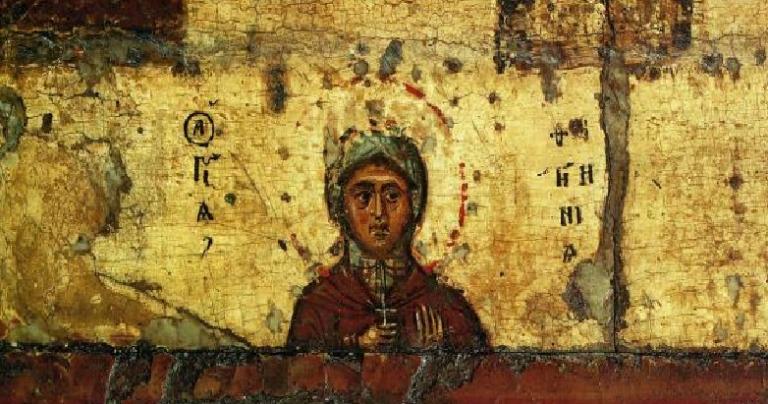
The Bible is filled with unnamed characters who eventually acquired a name and identity from legend or extra-biblical literature. Without doubt, the nameless wife of Noah (Genesis 6:18ff) has been assigned the largest amount of legendary names, 103 in all.
How do all these legendary names proliferate? Pilch says it results from the synergy of a prolific “fertility of pious imagination” added to “the unwillingness to respect the silence and gaps of the biblical narratives.” The extremely popular “The Passion of the Christ” by Mel Gibson and “The Da Vinci Code” (both Ron Howard film and Dan Brown novel) testify to the appeal of this enduring synergy.
There are numerous irregularities with this story. Let’s explore a few.
Perceiving Gender-Divisions
The Second Vatican Council’s Dogmatic Constitution on Divine Revelation—
“Due attention must be paid to the customary and characteristic style of perceiving, speaking, and narrating which prevailed at the time of the sacred writer, and to the customs [human beings] normally followed at that period in their everyday dealings with one another” (n. 12).
Consider that phrase “style of perceiving” in the above paragraph. As a 21st century United States person, I don’t ever worry when I enter a movie theater about sitting down wherever I like (unless, of course, my seat is pre-selected). If I went to the front of an average American movie theater and looked it over, I would see many unrelated women and men intermingled. No sweat for my American self! But this arrangement would shock and scandalize our Mediterranean ancestors in the faith!
The world of the Bible is sharply gender-divided. Some places are masculine in this Mediterranean cultural world (field, marketplace, gate, and generally the public outdoors). Other places are feminine (e.g., the home and kitchen). But the gender of some Mediterranean places changes depending on the time. The well is one such place. Therefore while it can be occupied by both males and females, ordinarily this should not happen at the same time. Women come the well at morning and evening (Genesis 24:11), whereas men come during the day. Thus, the Samaritan Woman is out of bounds (John 4:6-7)!
Why do you think that the Samaritan Woman comes to the well at noon? Probably she does this so as not to be seen by other women. This odd behavior screams to the Mediterranean audience hearing the Fourth Gospel being read that this woman is shameless (lacking a positive sense of shame, see John 4:16-18). The woman is alone, likely trying to avoid being shunned by her female peers.
Talking with Men!!??
Two other strange peculiarities would strike ancient audiences to “John.” The first is why would a Judean ever have anything to do with a Samaritan, much less strike up a conversation? But the second is even more irregular—why would a woman be talking in public with a strange man? The Samaritan Woman understands this plainly (John 4:9). And Jesus’ own disciples are scandalized by this (John 4:27).
Then, after being enlightened by the Johannine Jesus, the Samaritan Woman goes and tells what has happened to her to Samaritan men in the village marketplace! Again she is in the wrong place at the wrong time! Incredibly, she tells the men there that Jesus was aware of something known by all of them—she is shameless. In talking about her married status, Jesus somehow knew that she disregarded the cultural rules overseeing the right behavior between men and women.
What is this Story About?
To find out what this Gospel story is all about, let’s learn how to read it. According to Pilch, this Sunday’s Gospel is an example of cultural subversion and cultural innovation. In a meticulously constructed seven-part dialogue (with each speaker speaking seven times), the Samaritan Woman becomes what Pilch calls, “the most carefully and intensely catechized person in this entire Gospel!”

She moves from hateful ignorance into being enlightened, step-by-step going from misunderstanding into the light of clarity.
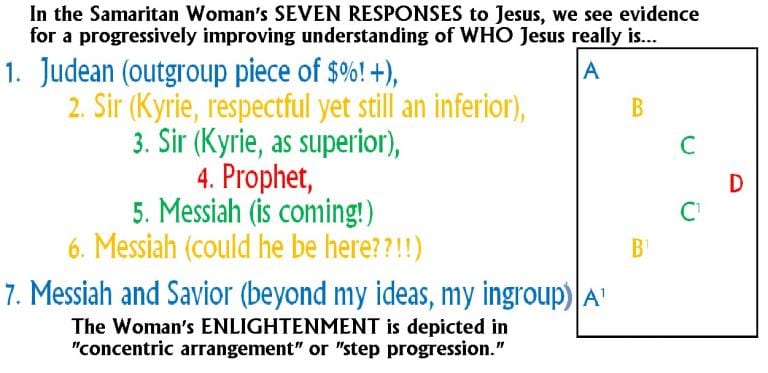
Could it be that the unknown author we call “John” is saying something about new roles for women in the Johannine Jesus group?
What is really going on here and what is “John” trying to communicate with his subversive story? Feminist scholars marvel at how the Johannine Jesus seems to commission her into being a disciple and evangelist! Was he really doing that? Other scholars focus on well-symbolism, sexual and marriage motifs and how everything in the story is wrong. Are these scholars correct?
What if both these groups are wrong? Let’s explore more later…






